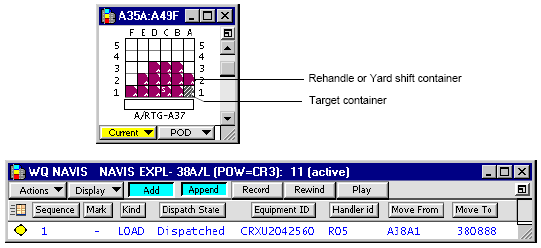
Quite often, a CHE operator must fetch a container that is stacked beneath one or more containers. The operator shifts containers that are on top of a target container, and places them in available slots elsewhere in the yard. This type of move is also called a rehandle or restow.

If a rehandle is required according to the Equipment Control inventory:
Equipment Control automatically provides a rehandle message in the VMT for the CHE operator. It includes:
-- The ID number of the container that needs to be rehandled.
-- A suggested position for the rehandled container. (Usually this is nearby, but is optimized depending on your yard allocations or licensed options.)
If the suggested position is unavailable for any reason, the CHE operator enters the actual position where the container was moved.
If the weight of the container to be rehandled exceeds the CHE's maximum weight, an error message is displayed.
The Pools & Equipment window displays the target container dispatched to the CHE, but with a Dispatch State of ‘Digging’.

For any rehandle, XPS creates and completes a special shift work instruction in the Work Queue. The work instruction’s Move Kind attribute is SHFT, and it receives the same sequence number as the target move. If you display the Move Kind attribute in the Work Queue list, you can identify completed SHFT work instructions to see how and when rehandles took place, as well as the last planned position for the container. If necessary, a yard planner can re-plan shifted containers to avoid further rehandles.
If the rehandled container has a planned move (which is often the case), its work instruction is unaffected, except that Equipment Control updates the current container position. The work instruction remains in its work queue, in its original sequence.
XPS provides a rehandle position that satisfies the following conditions.
The truck lane is considered and the rehandle is planned to a position that is far away from the truck lane.
The rehandle is not planned to a stack that has planned containers.
The rehandle is planned to a lower tier in a stack.
If all the stacks have planned containers, the rehandle position can be on top of planned containers, provided rehandles is minimum.
The CHE's lift over capability is considered while determining the rehandle position.
If OPTREH is set to N, XPS provides a position for the rehandle container based on the allocation range, which is the existing behavior.
This setting applies only to RTG/RMG blocks.
To perform a rehandle:
In the VMT job message for a target container that requires a rehandle, Equipment Control automatically provides the container ID and a suggested nearby position for the rehandle.
The CHE operator checks to make sure that the container Equipment Control identifies is indeed the one in the slot. If it is not, the operator cancels the job, and self-dispatches the rehandle container to the suggested rehandle position, or another position.
The CHE operator can accept the suggested rehandle position, or enter another position.
If a rehandle container (covered container) does not have an allocation range in the current section, XPS plans the container based on the container's allocation range. With OPTREH set to Y, you can force XPS to rehandle the container to the current section even if it's not part of the rehandle container's allocation range. This setting only applies to RTG/RMG blocks.
When the operator accepts the suggested position or enters another position:
Equipment Control updates the container position in all XPS lists and views, including the work instruction (if any) for the rehandle container.
A SHFT work instruction appears in the work queue for the target move. (When a CHE operator performs the rehandle move, XPS displays the corresponding CHE zone in greenish blue color. )

In the example, the rehandled container has a work instruction in the same work queue as the target container.
The original target work instruction appears on the VMT.
In the Pools & Equipment window, the Dispatch State is now that of the target move (in the example, ‘Vessel Load’). The operator can now perform the target move.
